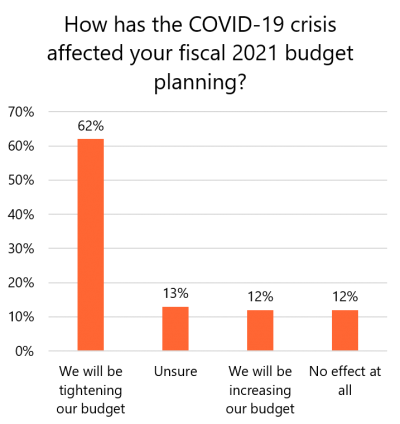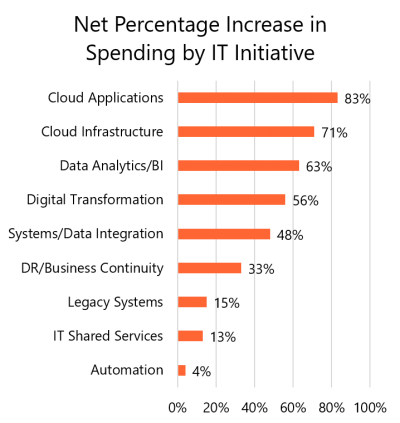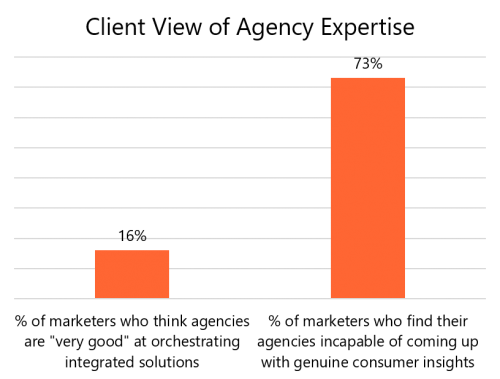IgniteTech is proud to share our advice in navigating the upcoming uncertainty of 2021 in this 4-part blog series compiled from expert resources, client feedback and our own experiences. Be sure to check out Part 2: Tech Stack, Part 3: Workspace and Part 4: Software Substitutions over the coming weeks.
As the end of the year approaches, businesses all over the world are facing unprecedented difficulty and uncertainty as they budget for FY21. More than ever, we need a strong budget to bounce back from the impact of COVID-19 and set up for success in 2021. However, it requires a strong and purposeful business case across all departments to secure what your team needs, particularly when it comes to tech.
When approaching their 2021 budget strategy, IgniteTech clients are giving us feedback of a number of possibilities, all difficult:
- Budgets are being drastically cut
- Budgets are staying flat YoY
- Spend and strategy are uncertain, therefore making it extremely difficult to plan
- Organizations have been introducing more arduous measures such as zero-based budgeting

There’s no doubt that we’re in a tough situation, but with the support of your trusted partners it can be easier. At IgniteTech, maintaining a streamlined budget has always been a key element of our strategy, such as our entirely-remote workforce and our use of our own quality software in order to keep costs down and use what our customers are using for a seamless experience.
We have compiled this knowledge alongside a number of reputable sources to develop this resource to make budgeting in uncertain times easier, including the key considerations and factors to guide you and serve as a solid strategic document.
Getting Started
As a starting point, we recommend plotting your costs out on a short- vs. long-term cost axis and a fixed vs. variable cost axis to create a clear overview of your cost structure. If you take paid digital for example, that could be classed as a short-term, variable cost and could be reduced by reassessing agency scope. According to Forbes, the key things to consider here are long term goals, the capex of your future projects and risk assessment. Furthermore, when making your case for the 2021 budget, first consider the following:
- Leverage analyst reports and industry research
- Link new initiatives to your organization’s long-term business goals
- Highlight team successes throughout the year
Then, according to Gartner, it’s important to look at your costs under three headings:
- Programs
- Partners
- People
Programs
In an ideal world, you would be granted all your 2021 budget wishes. While we have definitely been discouraged this year, that doesn’t mean all hope is lost. After all, success in the New Year is imperative, and it’s going to take the right tools and programs to get there.
Gartner’s CIO Roadmap to Strategic Cost Optimization provides these top questions of cost optimization:
- Is the scope of the initiative to cut, optimize or transform?
- What are the key stages and activities?
- Which leaders and teams need to be involved?
These questions define the scope of an initiative in an important way by helping you to holistically view an initiative in terms of its cost structure, dependencies and impact. When developing program recommendations, it’s crucial to remember that budget cuts may be the easiest option, but they are not always the best option. Cuts should be a tactic to unlock your budget for the tools and strategic initiatives that will generate a positive ROI.
To make these difficult decisions, critically assess the current program with the top and bottom lines in mind. It may turn out that restructuring spending may keep soft costs in check while generating similar revenue. In that case, it would be more advantageous to keep than cut that program.
Assessing your program recommendations in this manner instantly boosts your case for the 2021 budget. You want to communicate to fellow stakeholders and decision makers that it’s not simply a push for more, but a careful consideration of programs that will effectively contribute to 2021 success.
This is especially important when optimizing your tech budget. According to Gartner’s predictions, as revenues decline and IT projects back up, CIOs “will gravitate toward spending on subscription products and cloud services to lower upfront costs” (see graphic below). It’s not a simple case of changing priorities, but rather a realignment for survival.

But this situation is not all doom and gloom. It’s also an opportunity to invest in sustainable programs that will create value in the long term. As Forrester predicts (emphasis added):
“2021 will be the year that every company — not just the 15% of firms that were already digitally savvy — doubles down on technology-fueled experiences, operations, products, and ecosystems. Yes, that means investing in some new technology. But with the pandemic still a reality and budgets rightfully under scrutiny for 2021, it also means taking advantage of and realizing the value of the technology that you already have — and finally retiring the technical debt holding you back.”
While the pandemic may have forced many companies to quickly adapt to new realities — such as remote work, digital-first sales & customer engagement and more — much faster than expected, this isn’t just a time to survive. This is an opportunity to reset and retool existing processes to thrive for the next five or ten years. And many business leaders see that, according to McKinsey:
“In [a] 2017 survey, nearly half of executives ranked cost savings as one of the most important priorities for their digital strategies. Now, only 10 percent view technology in the same way; in fact, more than half say they are investing in technology for competitive advantage or refocusing their entire business around digital technologies.”
Use tech optimization, especially in these fast-changing times, as an opportunity both to reduce short-term spending for survival but also to eliminate tech debt that will affect the budget for years to come.
Partners
In order to produce a budget that works going into 2021, you must assess partnerships and agency relationships that aren’t serving you. Are you experiencing adequate ROI from your partnerships that justifies the spend?
Many of the decision points related to justifying a partner relationship are similar to the ones described above in the Programs section. However, working with an outside organization adds an extra layer of complexity based on the state of the relationship and your organization’s ability to handle similar functions in-house.
When assessing your partnerships, we recommend asking the below questions to guide decision making around budgeting:
- Is the relationship difficult? Are you or your team spending significant time trying to get things done with this agency or partner?
- Could the service be easily consolidated or assigned in-house?
- Be ruthless, does this agency or partner really add significant value?
- Do they produce low-impact output?
If the answer to any of the above is yes, then it may be time to reassess the partnership. For example, an agency may produce high-quality work, but the relationship is difficult to manage. Looking at the amount you pay them compared to the value you receive, the ROI is positive. But when you include the soft costs associated with the partnership, such as the time spent managing and extracting output from the agency, the value of the relationship decreases.
According to Hubspot, only 16% of marketers think that their agencies do an exceptional job at their given activities. If you are experiencing similar disappointment, it is even more important to closely examine the relationship.

Similarly, organizations managing changes may have partnerships that no longer fit the scope of the team or function in question. A growing company may have needed an agency to support a function that they now have the talent in-house to manage. Or a strategic partnership may no longer make sense for an organization in the process of divesting or spinning off business units.
No matter the agency or partnership relationships involved, 2021 is the perfect reset opportunity to audit outside relationships and ensure that they are positively impacting your budget. By taking a different approach to these partnerships, you may be able to make the cost savings needed to allocate toward higher priorities.
People
Perhaps the most difficult category of budgeting, more so now than ever, is looking at your people-related costs.
Let’s look again to Gartner’s CIO Roadmap to Strategic Cost Optimization and apply it to making workforce adjustments:
Is the scope of the initiative to cut, optimize or transform? As it pertains to people, this may mean considering:
- Have you mapped out the wider implications of headcount cuts on output and productivity or retained staff and departing staff?
- Is there a possibility to maintain or transfer operational knowledge?
- How will the headcount adjustments affect business into H1 2021?
Although payroll adjustments can make a significant short-term impact on a budget shortfall, it’s always a difficult decision. Cutting jobs can have far-reaching effects and soft costs beyond the immediately impacted teams — lost institutional knowledge, decreased morale, lowered productivity. Unhappy employees and disgruntled former employees can even be a risk to your organization’s information security and employer or public brands.
Where possible, a reorganization of headcount is the optimal scenario, whereby you may not be able to add headcount in 2021, but instead you can reallocate people resources to sustain jobs within your business and get more value from employees. This relates to the above Programs and Partners sections, as for example, reallocating employees’ time to take over for a function previously handled by an agency — or even reassigning employees to a program that needs additional investment to succeed — could save money while keeping talent on the team.
Conclusion
We hope that this guide has been a help to you when it comes to budgeting for 2021. It has definitely helped us internally to prioritize and ensure that our budget structure for next year positions us for success. At IgniteTech, we’re committed to 100% customer success to ensure our customers get optimal value from their solutions. We’re not in usual times, but simple switches and replacements, like activating your IgniteTech Unlimited entitlement, can potentially bring huge cost savings. Customers leverage IgniteTech Unlimited in three ways: to add new capabilities, to cut costs on tech that they can replace through the IgniteTech Unlimited program and to augment their existing IgniteTech solution.
Our next installment of this blog series will cover optimizing your tech stack for 2021 and beyond. In the meantime, please don’t hesitate to contact your IgniteTech client advisor at any time to discuss streamlining your software costs in 2021.






